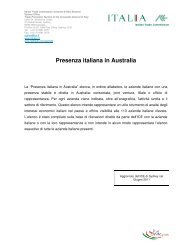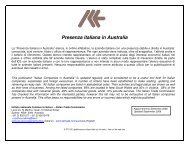Price Determination in the Australian Food Industry A Report
Price Determination in the Australian Food Industry A Report
Price Determination in the Australian Food Industry A Report
You also want an ePaper? Increase the reach of your titles
YUMPU automatically turns print PDFs into web optimized ePapers that Google loves.
DAIRY – PACKAGED MILK<br />
Overview of <strong>the</strong> product<br />
The packaged milk market consumes about 17 per cent of total milk output accord<strong>in</strong>g to 2003<br />
numbers.<br />
Packaged milk is a traditional product category on which much of <strong>the</strong> <strong>in</strong>dustry production<br />
technology and culture was orig<strong>in</strong>ally based – a commitment to service <strong>the</strong> fresh milk needs of <strong>the</strong><br />
community. Significant changes have been seen through <strong>the</strong> cha<strong>in</strong> as a result of technologies<br />
which have improved milk qualities, logistics systems capabilities and shelf life, as well as changes<br />
<strong>in</strong> consumer preferences towards greater convenience and health consciousness.<br />
The history<br />
The <strong>in</strong>dustry has a background history of regulated prices through <strong>the</strong> cha<strong>in</strong> at po<strong>in</strong>ts which<br />
<strong>in</strong>cluded factory gate, wholesale and back of store, and retail. The last piece of pric<strong>in</strong>g regulation<br />
was removed on 1 July 2000 with <strong>the</strong> removal of farmgate regulated prices for milk used <strong>in</strong><br />
packaged milk products.<br />
The product–market mix<br />
About 55 per cent of packaged milk sales <strong>in</strong> <strong>the</strong> domestic market are made through major<br />
supermarket cha<strong>in</strong>s.<br />
The product mix has changed significantly over <strong>the</strong> past 10 years towards products with lower fat<br />
content, although white whole milk dom<strong>in</strong>ates volumes.<br />
Figure 6. Milk product mix<br />
%<br />
100<br />
80<br />
o<strong>the</strong>r<br />
<strong>Price</strong> <strong>Determ<strong>in</strong>ation</strong> <strong>in</strong> <strong>the</strong> <strong>Australian</strong> <strong>Food</strong> <strong>Industry</strong> A <strong>Report</strong><br />
60<br />
40<br />
20<br />
0<br />
1990 2002<br />
Year<br />
Source of data on this and next page: Dairy Australia 2003<br />
Drivers of pric<strong>in</strong>g<br />
flavoured<br />
reduced fat<br />
low-fat<br />
whole<br />
A number of factors have significantly altered pric<strong>in</strong>g <strong>in</strong> <strong>the</strong> packaged milk value cha<strong>in</strong> <strong>in</strong><br />
recent years:<br />
• deregulation of pric<strong>in</strong>g and supply laws that existed at state level, which <strong>in</strong>cluded farmgate,<br />
wholesale and retail prices;<br />
• major retailers moved to national supply contracts <strong>in</strong> packaged milk;<br />
• <strong>the</strong> existence of excess capacity <strong>in</strong> milk packag<strong>in</strong>g operations <strong>in</strong> <strong>the</strong> three major processors,<br />
coupled with <strong>in</strong>creased awareness by retailers of <strong>the</strong> costs of milk production and process<strong>in</strong>g;<br />
• <strong>the</strong> use of private label products at a discount from proprietary branded products underp<strong>in</strong>ned a<br />
ga<strong>in</strong> <strong>in</strong> market share by cha<strong>in</strong> retailers;<br />
20







